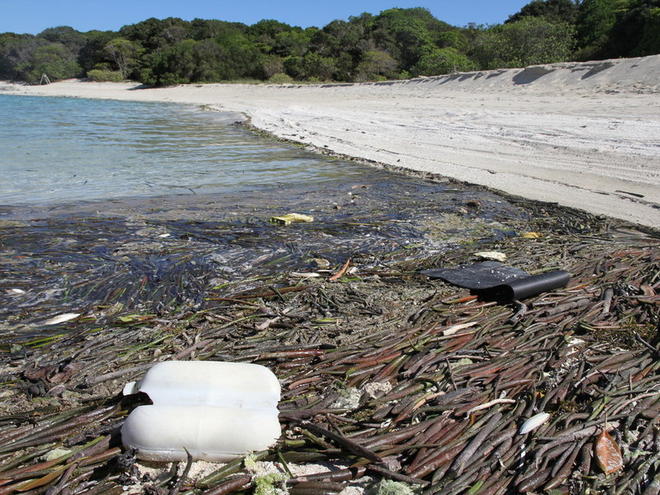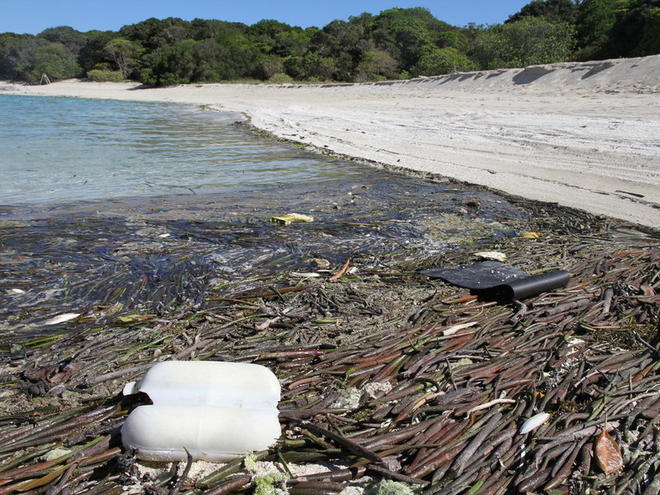An uninhabited Australian island littered with plastic
Published by the World Wildlife Fund

A tiny, uninhabited island, visited only by nesting turtles and crocs, situated in the middle of nowhere, is now choking with plastic.
Recently, I had the opportunity to visit Milman Island, a small sandy quay in the northern Great Barrier Reef, home to a project trialing methods to reduce the impacts of climate change on sea turtle populations.
I’d envisioned Milman Island as an untouched paradise with sparkling turquoise waters, sea turtles nesting on its white sandy dunes and tiny hatchlings making a dash toward the ocean.
When I stepped off the boat onto its shores, I thought to myself, I’ve really lucked out. As it turned out, Milman Island had all this and more.
Except the ‘more’ was something I didn’t exactly have in mind: Plastic.
Although Milman Island is uninhabited by humans and the closest township, Horn Island, is a 3-hour or 62 mile boat ride away, plastic waste covers its postcard-perfect beaches.
The contrast was confronting.
On a single lap around the island on a marine debris clean up, the WWF team and I found a bizarre array of rubbish, including high heeled shoes, a dishwashing machine cover, gas tanks, windshield wipers, toothbrushes, toy cars and so much more.
Some pieces of debris had barnacles growing over them or were rusted beyond recognition, an indication of just how long they’d been exposed to the elements. Others included an industrial piece of rubber from which thongs had been cut. Plus, large fishing nets were wedged under rocks and had been there for years, I’m told. Pieces of polystyrene foam were littered across the shores, some of which had tiny bite marks from turtles mistaking it for food. Items including a bedpan, which washed up long ago, were now half buried in the sand.
| Item | Pieces collected |
| Plastic bottles (various sizes, including drinking bottles and others) | 287 |
| Thongs | 144 |
| Thong pieces | 60 |
| Fishing gear | 37 |
| Light bulbs | 6 |
| Personal hygiene bottles (shampoo, deodorant etc) | 21 |
| Plastic shards large | 69 |
| Plastic shards small | 439 |
| Lighters | 15 |
| Polystyrene foam | 112 |
The total of 15 bags weighed over 165 pounds. 165 pounds on a single tiny quay that no humans call home.
And sadly, this is just a blip in the vast plastic problem. A staggering eight million tonnes of plastic finds its way into the world’s oceans annually. Over time, plastic debris breakdowns into tiny, near invisible particles known as microplastics. These are ingested by fish and marine life. And in a weird, karmic kind-of-way then passed up the food chain, prey to predator (humans included).
For me, the reality of this plastics problem really sunk in several times on the beach clean up. The first was when I picked up an ancient-looking plastic bottle that instantly disintegrated into tiny shards in my bare hands. I looked on in horror wondering how could I possibly pick up these minute pieces that had now almost disappeared into the sand. After this, WWF’s Marine Species Manager, Chris Hof asked us to do an exercise. She drew a 1 x 1 meter square in the sand. She gave us five minutes to sieve through the sand and pick up as many microplastics as possible. On closer inspection, it was shocking to see this section of sand, which otherwise looked fairly waste-free, was actually peppered with red and blue fragments of microplastic.
These fragments are just as deadly to marine life as a plastic bag, straw or abandoned fishing net – if eaten, over time they fill up the stomachs of marine marines, literally starving them to death.
The second instance was when we came across a spot where we had monitored a nesting turtle the previous night. With the benefit of daylight, we could now properly see the nesting site and what surrounded it: a broom head, a laundry detergent bottle and a thong . This turtle, and many others on the island must manoeuvre past obstacles like these and when their young hatch and head to the ocean, they too will encounter this. Although we picked up the litter surrounding the nest, sadly this is not the end of the problem. More will wash up tomorrow. And the day after that.
It’s easy to feel disillusioned by the numbers and the scale of the problem, but it’s not all doom and gloom. Individually, we can all play our part and make a difference. By reducing our use, saying no to single-use plastics and disposing of waste correctly, we can reduce the amount that ends up in the ocean. Our plastic pollution problem was created in just a generation. The good news is, we have the solutions to fix it within a generation.
Remember, even the smallest action can have a big impact. Sign our petition calling for a global treaty to end plastic pollution forever.
Read the full article at: http://feedproxy.google.com/~r/WWFStories/~3/uEfk5gaUUfo/an-uninhabited-australian-island-littered-with-plastic


